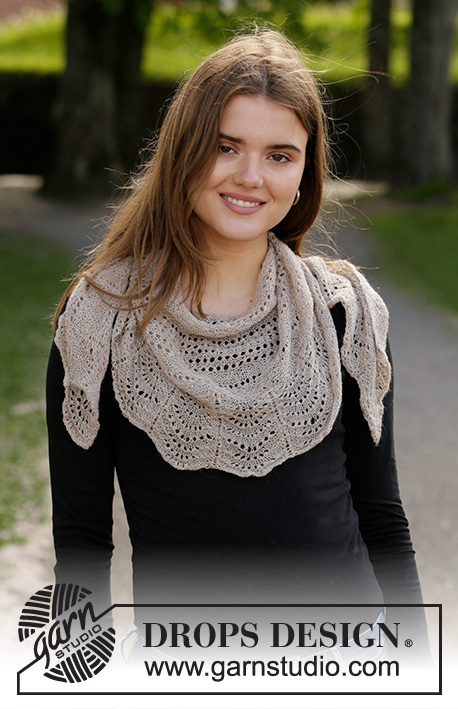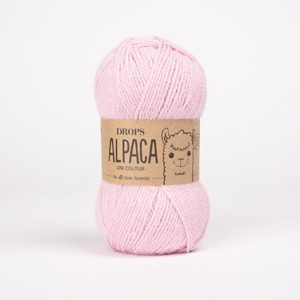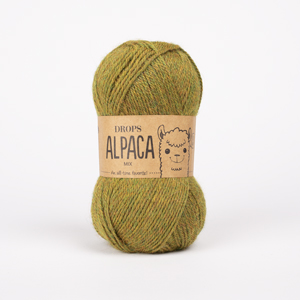Comments / Questions (35)
![]() Francesca wrote:
Francesca wrote:
Il ferro 1, manca la prima maglia non può incominciare il ferro con il gettato.
05.06.2025 - 14:09DROPS Design answered:
Buonasera Francesca, nella sezione video riportata di fianco alla foto, può trovare dei tutorials per iniziare il ferro con un gettato. Buon lavoro!
10.06.2025 - 00:03
![]() Chantale wrote:
Chantale wrote:
À quel endroit les corrections sont indiqués? Correction des explications du RANG AJOURÉ. Corrections entre la CÔTE MOUSSE D'AUGMENTATIONS-3 et la CÔTE MOUSSE D'AUGMENTATIONS-4
07.02.2025 - 16:01DROPS Design answered:
Bonjour Chantale, les corrections ne s'appliquent que si vous aviez déjà imprimé les explications avant la date de ces mêmes corrections, sinon, les explications en ligne sont déjà corrigées. Bon tricot!
07.02.2025 - 16:10
![]() Sabine Simma wrote:
Sabine Simma wrote:
Hallo liebes Drops-Team, Ich habe eine Frage zu A1 : In der 27. Reihe = 4. Lochreihe sind im Diagramm 8 Umschläge/ Löcher eingezeichnet. Auf dem Bild sind aber 10 Löcher zu sehen . Wie mache ich weiter? Das Tuch ist sehr schön und aufgrund der vielen Maschen würde ich es ungern aufribbeln. Ich freue mich auf Ihre Antwort
09.07.2024 - 15:08DROPS Design answered:
Liebe Sabine, Sie brauchen es nicht aufzuribbeln - stricken Sie einfach gemäß Diagramm weiter, auch wenn auf dem Foto 2 Löcher mehr erscheinen. Es ist wichtig, dass Sie die passenden Zunahmen im Muster A.1 machen, damit das Tuch unten breit genug wird und nicht spannt, und diese Zunahmen sind im Diagramm stimmig. Viel Spaß beim Weiterstricken und Tragen des Tuches!
12.07.2024 - 23:15
![]() Danielle Langlois wrote:
Danielle Langlois wrote:
Combien de mêtres de fil faut-il pour faire ce châle
14.04.2024 - 22:37DROPS Design answered:
Bonjour Mme Langlois, 1 pelote Alpaca fait environ 167 m (cf nuancier et il faut 5 pelotes (250 g / 50 g la pelote); 1 écheveau de 100 g Lace (avant d'être sous forme de pelote, Lace était sous forme d'écheveau) faisait environ 800 m (cf fils épuisés. Bon tricot!
15.04.2024 - 08:27
![]() Eva wrote:
Eva wrote:
Guten Tag, beinhalten die Musterzeichnungen die Rückreihen oder nicht? danke LG Eva
15.05.2023 - 12:18DROPS Design answered:
Liebe Eva, alle Reihen sind im Diagram gezeichnet, die Hin-Reihen (lesen Sie rechts nach links) sowie die Rückreihen (lesen Sie links nach rechts). Viel Spaß beim stricken!
15.05.2023 - 13:23
![]() Sabbi wrote:
Sabbi wrote:
Sind bei Diagramm A1 nur die Hinreihen oder auch die Rückreihen angegeben? Mich irritiert, dass beim Zeichen Karo mit Minuszeichen drinnen = 1 Masche rechts in Rück-Reihen steht. Wie strickt man da in der Hinreihe?
11.04.2022 - 16:16DROPS Design answered:
Es sind sowohl Hin- als auch Rück-Reihen angegeben. Das "Minuszeichen-Symbol" gibt es nur in Rück-Reihen, darum ist eine Beschreibung, wie es in Hin-Reihen gestrickt wird, überflüssig. Viel Spaß beim Stricken!
13.04.2022 - 20:49
![]() Gordana wrote:
Gordana wrote:
Vielen Dank für die Anleitung Bin schon beim 2. Fast fertig 3 ist schon in Planung LG
22.11.2021 - 23:40
![]() Maria Grazia Alcanello wrote:
Maria Grazia Alcanello wrote:
Buon giorno e grazie per la presentazione di tanti modelli veramente deliziosi. Ho realizzato questo scialle, ma per l'insolita forma, credo di aver sbagliato a non continuare gli aumenti all'inizio di ogni giro, a cominciare dal punto pavone. E' così ? Grazie e cordiali saluti.
25.10.2021 - 16:06DROPS Design answered:
Buonasera Maria Grazia, per la parte a punto pavone deve lavorare come indicato, con 2 maglie di vivagno a ogni lato. Buon lavoro!
26.10.2021 - 19:52
![]() Sabine wrote:
Sabine wrote:
Bonjour J’en suis au 4ème rang de jours dans le point de vagues et en regardant de plus près la photo du modèle je constate que la grille ne correspond pas ! Le nombre de jours n’est pas identique !? D’autres part : il n’y a plus d’augmentations sur les côtés quand on tricote la grille finale ? Ce châle n’est donc pas vraiment triangulaire ? Merci
22.06.2021 - 23:29DROPS Design answered:
Bonjour Sabine, le châle n'est pas un triangle mais plutôt un demi ovale très allongé; lorsque vous tricotez le point de vagues, vous n'augmentez plus que dans le point de vagues (il se tricote d'abord sur 15 m et quand il est terminé, vous aurez 25 m dans chaque A.1). Bon tricot!
23.06.2021 - 07:54
![]() Silke wrote:
Silke wrote:
Wann gibt es die Drops LACE mit der Lauflänge 400mm/50g wieder im Programm, damit ich es nachstricken kann.?
04.05.2021 - 06:32DROPS Design answered:
Liebe Silke, sowas haben wir nicht vor, aber wenn Sie die selbe Zusammensetzung möchten, dann können Sie gerne DROPS Baby Alpaca Silk stricken. Viel Spaß beim stricken!
04.05.2021 - 07:53
December Dunes#decemberdunesshawl |
||||||||||||||||||||||
 |
 |
|||||||||||||||||||||
Knitted shawl in DROPS Alpaca or DROPS Lace. Piece is knitted top down with garter stitch, eyelet rows and wave pattern.
DROPS 203-17 |
||||||||||||||||||||||
|
---------------------------------------------------------- EXPLANATION FOR THE PATTERN: ---------------------------------------------------------- GARTER STITCH (back and forth): Knit all rows. 2 rows = 1 ridge. EYELET ROW: When working eyelet row, increase at the beginning of the row as before. Work as follows: ROW 1: Make 1 yarn over, knit 1, 1 yarn over, knit 1. * knit 2 together, 1 yarn over *, work from *-* until 3 stitches remain, and knit 3. ROW 2: Make 1 yarn over, knit 1, 1 yarn over, knit the rest of stitches. INCREASE TIP-1 (evenly): To calculate how to increase evenly, use the total number of stitches on row (e.g. 33 stitches) and divide stitches by number of increases to be done (e.g. 12) = 2.7. In this example increase by making 1 yarn over after alternately every 2nd and 3rd stitch. On next row knit yarn overs twisted to avoid holes. INCREASE TIP-2: If the knitting tension is incorrect the shawl can have the wrong number of stitches if you need to work more or less rows than stated to get the correct measurements in cm. This error can be corrected on next increase ridge. If you work to tightly, so that e.g. 6 cm is not 15 ridges as in pattern, but e.g. 16 ridges, there will be 4 or 2 stitches to many on needle (depending on it being before or after INCREASE RIDGE 3). If you work to loose, there will be too few stitches on needle when worked to given measurements in cm. This can be adjusted on next increase ridge, so that number of stitches is the same as number of stitches given when increase ridge is done. PATTERN: See diagram A.1. Diagrams show all rows in pattern seen from the right side. SHAPING: Place the piece in lukewarm water until it is soaking wet. Carefully squeeze out the water - do not twist. Then roll the piece in a towel and squeeze to remove more water. The piece will now only be moist. Place the piece on a carpet or mattress - carefully stretch it out to measurements found under SIZE at the top of pattern and leave to dry. Repeat the process when the piece has been washed. ---------------------------------------------------------- START THE PIECE HERE: ---------------------------------------------------------- SHAWL - SHORT OVERVIEW OF THE PIECE: Worked back and forth on circular needle to make room for all the stitches. Most of the shawl is worked in GARTER STITCH - read explanation above, work the edge at the bottom in wave pattern. SHAWL: Cast on 13 stitches on circular needle size 3.5 mm with Lace. Knit 1 row from wrong side. Continue as follows: ROW 1 (= right side): Make 1 yarn over, knit 1, 1 yarn over, knit the rest of stitches (= 2 stitches increased). ROW 2 (= wrong side): Make 1 yarn over, knit 1, 1 yarn over, knit the rest of stitches (= 2 stitches increased). Work in garter stitch and continue to increase 2 stitches at the beginning of every row until 4 ridges have been worked in total from beginning (= 4 stitches increased per ridge) = 29 stitches. Work 1 EYELET ROW - read explanation above (= 4 stitches increased) = 33 stitches. REMEMBER THE KNITTING TENSION! INCREASE RIDGE 1: Knit 1 row from right side while increasing 12 stitches evenly - read INCREASE TIP-1 in explanation over. Knit next row, knit yarn overs twisted = 45 stitches. Work in garter stitch and continue to increase 2 stitches at the beginning of every row as before until 3 ridges have been worked in total (including increase ridge) from previous eyelet row (= 4 stitches increased per ridge) = 53 stitches. *Work 1 EYELET ROW. Work in garter stitch and continue to increase 2 stitches at the beginning of every row as before until 3 ridges have been worked after eyelet row *, work from *-* 2 times in total (= 4 stitches increased per ridge/eyelet row) = 85 stitches. Work 1 EYELET ROW (= 4 stitches increased) = 89 stitches. INCREASE RIDGE 2: Knit 1 row from right side while increasing 21 stitches evenly. Knit next row, knit yarn overs twisted = 110 stitches. Work in garter stitch and continue to increase 2 stitches at the beginning of every row as before until piece measures 6 cm from previous eyelet row, equals approx. 15 ridges (including previous increase ridge) (= 4 stitches increased per ridge) = 166 stitches. If the number of stitches deviates, adjust on next increase ridge - READ INCREASE TIP-2 in explanation above. INCREASE RIDGE 3: Knit 1 row from right side while increasing 57 stitches evenly. There should now be 223 stitches on needle. Knit next row, knit yarn overs twisted. NOTE: Now the increase in the side will change from 2 stitches to 1 stitch (on eyelet rows also increase only 1 stitch in the side on each row) - increase and work as follows: ROW 1 (= right side): Knit 1, 1 yarn over and knit the rest of the stitches (= 1 stitch increased). ROW 2 (= wrong side): Knit 1, 1 yarn over and knit the rest of the stitches (= 1 stitch increased). Work in garter stitch and increase in the sides this way until 3 ridges in total have been worked from previous increase ridge (= 2 stitches increased per ridge) = 229 stitches. *Work 1 EYELET ROW - read explanation above. Work in garter stitch and continue to increase 1 stitch at the beginning of every row as before until 2 ridges have been worked in total after eyelet row *, work from *-* 4 times in total (2 stitches increased per ridge/eyelet row) = 253 stitches. Work 1 EYELET ROW (= 2 stitches increased) = 255 stitches. Work in garter stitch and continue to increase 1 stitch at the beginning of every row as before until piece measures 3 cm from previous eyelet row, equals approx. 7 ridges (= 2 stitches increased per ridge) = 269 stitches. If the number of stitches deviates along the way, adjust on next increase ridge - read INCREASE TIP-2. Work 1 EYELET ROW (= 2 stitches increased) = 271 stitches. INCREASE RIDGE 4: Knit 1 row from right side while increasing 64 stitches evenly. There should now be 335 stitches on needle. Knit next row, knit yarn overs twisted. Work in garter stitch and continue to increase 1 stitch at the beginning of every row as before until piece measures 3 cm from previous eyelet row, equals approx. 7 ridges (2 stitches increased per ridge) = 349 stitches. Piece measures approx. 25 cm measured on the middle from cast-on edge and down. Now it is important to have the correct number of stitches because of the diagrams. If you need to, you can work 1 more ridge and adjust the number of stitches if the number is incorrect. Work according to diagram A.1 as follows: Work 2 edge stitches in garter stitch, work A.1 (= 15 stitches) until 2 stitches remain on needle (repeat A.1 23 times) and work 2 edge stitches in garter stitch. Work diagram 1 time vertically. CAST-OFF: To avoid a tight cast-off, make yarn overs when casting off by knitting from right side as follows: Make 1 yarn over over the stitches that were yarn overs in pattern, cast off yarn overs as stitches. Make sure to avoid tightening the yarn along the way. If the edge still is tight use a larger needle size for cast-off. Cut and fasten the yarn. When shawl is done, wash and shape if you want - read SHAPING in explanation above. |
||||||||||||||||||||||
Diagram explanations |
||||||||||||||||||||||
|
||||||||||||||||||||||

|
||||||||||||||||||||||
Have you finished this pattern?Tag your pictures with #dropspattern #decemberdunesshawl or submit them to the #dropsfan gallery. Do you need help with this pattern?You'll find 19 tutorial videos, a Comments/Questions area and more by visiting the pattern on garnstudio.com. © 1982-2025 DROPS Design A/S. We reserve all rights. This document, including all its sub-sections, has copyrights. Read more about what you can do with our patterns at the bottom of each pattern on our site. |
||||||||||||||||||||||

































































Post a comment to pattern DROPS 203-17
We would love to hear what you have to say about this pattern!
If you want to leave a question, please make sure you select the correct category in the form below, to speed up the answering process. Required fields are marked *.